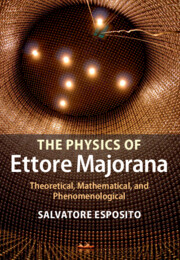Book contents
- Frontmatter
- Contents
- Acknowledgments
- Part I Introducing the character
- Part II Atomic physics
- Part III Nuclear and statistical physics
- 5 Quasi-stationary nuclear states
- 6 Theory of ferromagnetism
- Part IV Relativistic fields and group theory
- Part V Quantum field theory
- Part VI Fundamental theories and other topics
- Part VII Beyond Majorana
- Appendix Molecular bonding in quantum mechanics
- References
- Author index
- Subject index
5 - Quasi-stationary nuclear states
Published online by Cambridge University Press: 18 December 2014
- Frontmatter
- Contents
- Acknowledgments
- Part I Introducing the character
- Part II Atomic physics
- Part III Nuclear and statistical physics
- 5 Quasi-stationary nuclear states
- 6 Theory of ferromagnetism
- Part IV Relativistic fields and group theory
- Part V Quantum field theory
- Part VI Fundamental theories and other topics
- Part VII Beyond Majorana
- Appendix Molecular bonding in quantum mechanics
- References
- Author index
- Subject index
Summary
At the end of 1920s, the activities of the Fermi group in Rome focused almost exclusively on atomic physics and related subjects, as did the other major research centers throughout Europe. After having obtained several significant results in atomic and molecular spectroscopy, around 1930 some people in the group realized that such a field could no longer offer any great prospects, and Fermi himself predicted that the interest would shift from the study of the external parts of the atom to its nucleus. However, no general consensus was reached initially inside the group, and the spectroscopic activities continued, along with the acquisition of theoretical knowledge and experimental technologies required by nuclear physics, until 1934, when the Fermi group discovered the radioactivity induced by neutrons and the important properties of slow neutrons [231].
Majorana also actively participated in scientific discussions within the Rome group [10, 11], but, as we have seen in Section 2.6, we are left with only one published paper of his on nuclear physics topics (that is, paper(s) N.8), dealing with the Heisenberg–Majorana exchange forces in nuclei, while nothing was published of his previous works on these matters. Remarkably, Majorana was the first in Rome to study nuclear physics; in 1929 (on July 6) he defended his degree thesis on “The quantum theory of radioactive nuclei,” and his studies on such topics continued for several years, independent of the main line of research carried out by the Fermi group. In this chapter we will focus on these (unpublished) studies [232], performed around 1929–30, devoted mainly to nuclear reactions induced by α particles.
Probing the atomic nucleus with α particles
The first steps of nuclear physics were taken in the realm of radioactive phenomena, among which those involving α emission were readily recognized to induce a profound modification of the atomic nucleus by virtue of the large mass of the emitted particles.
- Type
- Chapter
- Information
- The Physics of Ettore MajoranaTheoretical, Mathematical, and Phenomenological, pp. 109 - 126Publisher: Cambridge University PressPrint publication year: 2014



